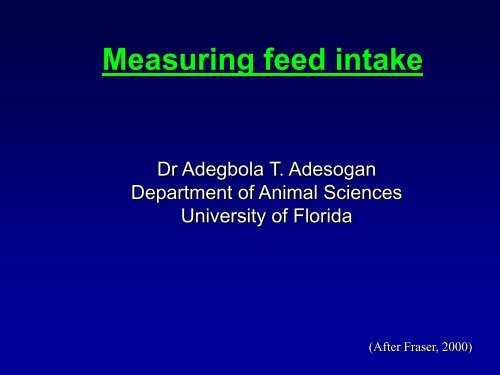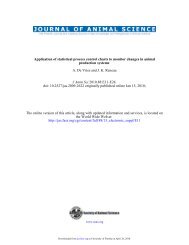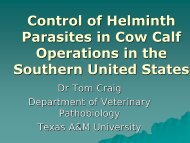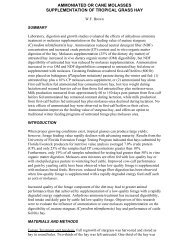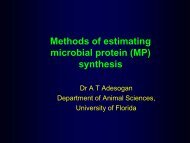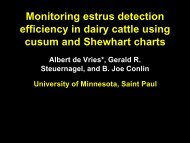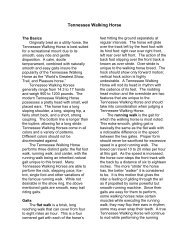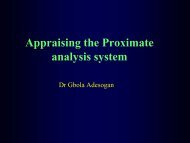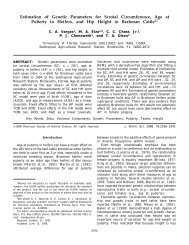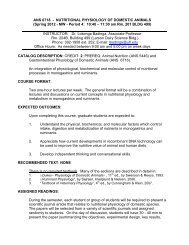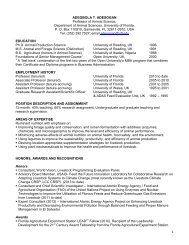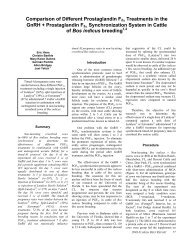14. Measuring Feed Intake - Department of Animal Sciences ...
14. Measuring Feed Intake - Department of Animal Sciences ...
14. Measuring Feed Intake - Department of Animal Sciences ...
- No tags were found...
You also want an ePaper? Increase the reach of your titles
YUMPU automatically turns print PDFs into web optimized ePapers that Google loves.
<strong>Measuring</strong> feed intakeDr Adegbola T. Adesogan<strong>Department</strong> <strong>of</strong> <strong>Animal</strong> <strong>Sciences</strong>University <strong>of</strong> Florida(After Fraser, 2000)
<strong>Intake</strong> measurement• Can be done– Under confinement (ideal for conserved forages)– Under confinement with artificial pastures– At pasture (ideal for grazed forages)
Determining intake in confinedanimals
Zero-grazing:<strong>Animal</strong> is confined in pens / stalls or tethered
Zero grazing criteria• Representativeness <strong>of</strong> grazing conditions• Frequency <strong>of</strong> feeding & refusal collection• Refusal analysis• Duration <strong>of</strong> adaptation period• Housing & no. <strong>of</strong> animals• <strong>Feed</strong>ing level choice & definition <strong>of</strong> ad. libitum i.ewhen is selection optimized ?
Zero-grazing:Pros• Easier replication than grazing• Ideal for conserved foragesCons• Selection is reduced• Affected by wilting / deterioration• Labor intensive• May be unrealistic for pasture assessments–No sward structure effects–No competition / social interaction
Calan gatesBruno’s website
Electronic gates• E.g. Calan gates / Broadbent doors• Pros– Allows single animal access to designated manger– Frees animals from confinement, allowing socialinteraction & exercise• Cons– Cost + training <strong>of</strong> animals– Stealing <strong>of</strong>ten occurs– Ideal gate dimensions depend on animal size– Circuits may fail
Calan gates at the BRU
Continuous-reading mangers• E.g. hoko feeders / Grow-safe system• Mangers placed on pressure sensors / strainguages• Monitor weight loss <strong>of</strong> manger every 10 s• Indicates intake kinetics (meal patterns)• Other pros & cons as for Calan gates
Hoko feeder
Grow safe system
Determining intake fromartificial pastures
What is being eaten & howquickly is it eaten?• Methods for determinining sward-structure &intake rate include using :1. Perforated boards2. Turves
Quantifying intake from bite sizeBite areaxBite depthBite volumexBulk density<strong>Intake</strong> =Bite weightxBite ratexGrazing timeShort-termLong-term +
• ProsPerforated (Sward-) boards:–Allow precise sward description e.g density,establishment etc.–Indicates bite area, bite depth etc• Cons–Short term – 30 s – 1 min.–Representativeness <strong>of</strong> artificial pasture• Alternatively, some studies limit access to 0.6 x0.5 m in a pasture
Turves:Method• Sow trays or cut from swards• Weigh tray & take height measurements• Offer to animal• Re-weigh & measure height• Correct for evaporation weight losses withcontrols
Turves:Pros• Accounts for sward structure–Useful for showing effects <strong>of</strong> real swards vsmixtures• Less deterioration <strong>of</strong> forageCons• Short-term• Is it representative
<strong>Measuring</strong> intake at pasture
Grazing cages:Pros• Accounts for sward structureCons• Time consuming• Short term• Is it representative• No competition etc
Herbage mass measurements:Method• Cut samples within quadrats to certain height• Position exclusion cages• Allow animals to graze• Take second set <strong>of</strong> quadrat cuts• Take cuts from within cages• Correct for plant growth with exclusion cagesamples.
Herbage mass measurement
Herbage measurements:Pros• No animal handlingCons• Need uniform sward (height) & even soil surface• Must be < 3 d in duration to ↓ pasture growth• Intensive sampling required• Error sources–Sampling & fouling, trampling, insect / otherherbivore feeding–Representativeness & diet selection–Leaf senescence & soil contamination
Short-term BW measurements :• Weigh animal (W 1 )• Allow animal to graze• Re-weigh animal (W 2 )• Account for weight losses during grazing–feces (F), urine (U) & insensible loss (I)–And any weight gain due to drinking (L)• <strong>Intake</strong> = (W 2 + F + U + I) – W 1 –L
Short-term BW measurements:Pros• Longer term than sward-boards (5 mins ?)• <strong>Animal</strong>s graze real pastureCons• Water intake & insensible loss quantification• Environment affects results– Wind, moisture etc affect result–Can use polytunnels – unrealistic–Ignores diurnal variation in intake• Should account for non-forage intake e.g soil,minerals etc but does not
<strong>Measuring</strong> grazing time/behavior:• Procedure– Watch / video animals at pasture–Record no <strong>of</strong> bites• Pros–Can be used on wild & domestic animals• Cons–Observer may affect behaviour–Usually short durations–May be subjective–Assumes bite mass constant
Vibracorders• Procedure–Works like truck tachographs–Vibrations from pendulum attached to neckrecorded on a chart–Measures grazing time when head is lowered forgrazing• Cons– Equipment may affect intake– Head lowering may not reflect biting (Need tocorrect this by recording head jerks)
Jaw recorders• Procedure–Resistance on meter changes as jaw moves–Data downloaded onto PC.–Differentiate rumination from eating cause <strong>of</strong>differences in jaw movements• Cons–May not work ontemperamental cows–Equipment may affectintake
Watch what you eat!!!!Python regrets gulping gator in the Everglades
Indirect intake estimationmethods• Generally based on relating digestibility orfecal output or fecal composition <strong>of</strong> thegrazed grass to intake
Total feces collection:Procedure• Measure feces with collection bags• Take representative herbage samples fordigestibility determinations in vitro• DM <strong>Intake</strong> = Fecal DM output(1-(DMD/100))
Total feces collectionPros• Gives individual intakes (with individual feeding)• Requires only DM & ash determinationsCons• Fecal bags may affect intake, selection & distorthind legs• Loss <strong>of</strong> fecal matter on low DM diets• Diarrhoea????• More appropriate for sheep due to drier feces
MethodMarkers:• Avoids the need for feces bags• Dose animals with marker (1 or 2 x daily /ruminal bolus)• Collect fecal samples• Fecal output = [Marker feed]/[Marker feces]
Internal markers• Main problem is getting a representative sample<strong>of</strong> what is grazed.• Most investigators have concluded that it isvirtually impossible to accurately, representativelysample what an animal eats from a pasture byhand.
Internal markers• E.g lignin, AIA, silica, fecal N, indigestible NDF,chromogens (indigestible plant pigments)• Main problem is getting representative sample <strong>of</strong>what is grazed.• Options– Manual selection (subjective)– Use oesophageally cannulated animal (saliva /rumen fluid contamination)
Internal marker problems• Silica is incompletely recovered & influenced bysoil contamination• Lignin in feces subject to diurnal variation• iNDF is incompletely recovered• Chromogens best for lush pasture, notdrought/stressed pasture.• AIA concentration in forages is low, hence largesamples required
External Markers - chromic oxide:Pros• Gives individual intakes (with individual feeding)• Suitable for long term studies for different spp.Cons• Carcinogenic – not used in UK, used in US• Laborious & stressful if daily dosing employed• Large diurnal variations in fecal markerconcentration with 1 x dosing• Continuous release devices may vary inmanufacturer-prescribed & actual release rates
DMI, kgEffect <strong>of</strong> treatments on hayintake (Krueger et al., 06)12Cr 2 0 3 dosing108642ControlNH3EnzcutEnzbaleEnzyfeed01 2 3 4 5 6 7 8 9 10 11 12weekMarkers can affect performance
Markers - Alkanes• Main component <strong>of</strong> plant surface (epicuticular)wax• Hydrocarbons with 21 - 37 C atoms• > 90% have odd # <strong>of</strong> C atoms in straight chains• C 29 , C 31 & C 33 are the most common in pastures.• Inert and relatively easy to analyze, hence widelyused to estimate digy, intake, passage rate etc.
Alkanes (C n H 2n+2 )• CH 4 CH 4 Methane• C 2 H 6 CH 3 -CH 3 Ethane• C 3 H 8 CH 3 -CH 2 -CH 3 Propane• C 4 H 10 CH 3 -(CH 2 ) 2 -CH 3 Butane• C 5 H 12 CH 3 -(CH 2 ) 3 -CH 3 Pentane• C 6 H 14 CH 3 -(CH 2 ) 4 -CH 3 Hexane• C 7 H 16 CH 3 -(CH 2 ) 5 -CH 3 Heptane• C 8 H 18 CH 3 -(CH 2 ) 6 -CH 3 Octane• C 9 H 20 CH 3 -(CH 2 ) 7 -CH 3 Nonane• C 10 H 22 CH 3 -(CH 2 ) 8 -CH 3 Decane
Markers - Alkanes:• Straight chain, hydrocarbons• Epicuticular plant alkanes can be used to measureintake & digestion• Plants have high levels <strong>of</strong> odd-chained alkanes,and low levels <strong>of</strong> even-chained alkanes• Alkane digestibility decreases with chain lengthe.g. recovery <strong>of</strong> C33 =0.37; C35= 0.95• Alkane pr<strong>of</strong>ile <strong>of</strong> each plant is unique– Fecal n-alkane pr<strong>of</strong>iles can also be used to identifydiet composition in grazing ruminants
Alkanes contd.• Fecal recovery <strong>of</strong> individual alkanes is incomplete,• But recovery <strong>of</strong> adjacent homologues is similare.g. C33 & C32 have similar recoveries• Therefore, we can dose with C32, measure fecalrecoveries <strong>of</strong> C32 & C33• Because the ratio <strong>of</strong> C32/C33 in feces is constant,incomplete recovery <strong>of</strong> either alkane does notmatter
<strong>Measuring</strong> intake with alkanes:• Dose with pair <strong>of</strong> odd and even chained alkanese.g. C 32 /C 33 (most effective).• Measure concentrations <strong>of</strong> both in feces• The odd chained alkane is the natural, plant-basedinternal marker• The even chained alkane is obtained from purifiedpreparations and is the external marker
Calculations• DM <strong>Intake</strong> (kg) =Fecal 33 x Dosed 32Fecal 32 Herbage 33• Digestibility = 1 - (<strong>Feed</strong> 36 / Fecal 36 )
Alkane analysis• Alkanes in a sample are separated bysaponification with KOH or extraction with nonpolarsolvents e.g. Heptane / hexane (safer)• This removes fatty acids as soaps or removes thelipids, both <strong>of</strong> which can interfere with the analysis• The alkanes are present in the non-lipid, orunsaponifiable fraction and are measured by GC
Alkanes continuedPros• Gives individual intakes for various spp.• New developments being made – slow releaseboluses – only administered onceCons• Requires several lab. analyses• Relies on accurate alkane extraction• Relies on representative sampling–difficult with mixed swards;–alkanes vary with spp & plant parts (low in C 4 grasses)
Fecal index methods• Based on inverse relationship b/w fecal N &digestibility• Relationship varies with animal & sward factors,hence different equations required for differentspecies.• Fecal NIRS spectra have also been used topredict digy. and therefore, intake
Pasture composition
Accurate representative sampling dependson diet selectedDiet selection: depends onPlant communityIndividual plantPlant part
Diet selection also varies with sppBrowsersGrazers
Diet selection:Factors affecting diet selection• <strong>Animal</strong>–Spp. & Size <strong>of</strong> animal–Mouth morphology & gut type–Physiological state–Parasite burden• Forage–Leaf to stem, weeds–Sward structure• Environment–Social environment – dominance, copyingothers–Physical environment – weather etc
Methods <strong>of</strong> estimatingdiet composition
Snip samples:Method• Cut or pick samples by handPros• Quick and cheapCons• Difficult to mimic grazing
Cages:Method• Compare forage under exclusion cagewith grazed pasturePros• Improved accuracyCons• Cages don’t suit all vegetation types• Number <strong>of</strong> cages required for patchysward
N-alkane markers:Principle–Alkane pr<strong>of</strong>ile in a mixture arises from a combination<strong>of</strong> the pr<strong>of</strong>iles <strong>of</strong> the components–Based on differences in alkane concentration indifferent speciesMethod–Analyse feces/ esophageal samples & hand pluckedsamples–Use simultaneous/ complex equations to calculatecomposition
N-alkane markers:Pros• Useful when #<strong>of</strong> alkanes > # <strong>of</strong> diet componentsCons• Complex computations• #. <strong>of</strong> alkane pr<strong>of</strong>iles available dictates # <strong>of</strong>species identifiable• Requires accurate control <strong>of</strong> dose rate• Requires plant pr<strong>of</strong>iles – plant composition &their alkane contents• Alkane contents vary with plant parts, soil type
Fecal analysis:Method• Collect fecal samples–Doesn’t have to be fresh• Examine under microscope for planttissue fragments
Fecal analysis:Pros• Minimal disturbance <strong>of</strong> animals• Can be used with free-ranging animalsCons• Accuracy• Under-estimates digestible component <strong>of</strong>diet & over-estimates indigestiblecomponents
GIT contents:Method• Shoot/kill animal (humanely)• Collect samples from rumen or gutPros• <strong>Animal</strong>s may be getting shot anywayCons• Is only an estimate <strong>of</strong> what it ate last• No scope for repeating measurements• Partial digestion will affect results
Surgical modification:• Prepare animal• Create fistula• Familiarize animal with sampling procedure• Collect samples (especially esophageal extrusa)Pros• Repeatable & AccurateCons• Ethical issues, short sampling time• Assumes behaviour <strong>of</strong> fistulates is similar to that<strong>of</strong> intact animals
Conclusion:There is no right answer
References• See website articles by Coleman.• Burns, J C, Pond, K R and Fisher, D S. 2.003. Measurement <strong>of</strong> forageintake. In: G Fahey et al., (eds) Forage Quality Evaluation andUtilization. American Society <strong>of</strong> Agronomy Inc., USA.• Coates and Penning 2000. <strong>Measuring</strong> animal performance. In:Fieldand laboratory methods for animal production research. CABInternational, Wallingford• Corbett, J L. Measurement <strong>of</strong> the forage intake <strong>of</strong> grazing animals.In:Wheeler and Mochrie (eds). Forage evaluation: Concepts andtechniques. CSIRO• Horn, F P. 1980. Direct measurement <strong>of</strong> voluntary intake <strong>of</strong> grazinganimals by Telemetry. In:Wheeler and Mochrie (eds). Forageevaluation: Concepts and techniques. CSIRO


